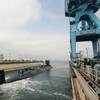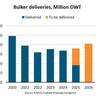The Shipping Lottery
And, as oil prices continue to rise – adding an average of more than 1% on Thursday – the effects on the world’s economy will soon to be clear to see. If energy prices stay at their present levels, analysts believe global growth could be cut by 0.5-1%. Add to that the largest ever world merchant vessel order book extending years ahead, with recent contracts booked at near record prices, and you could have the ingredients for a spectacular crash. London broker Clarkson sounded a note of caution less than a week ago. In a weekly report, the firm’s analysts noted four key points. “We are at the top of a cycle and cycles are unstable. Next year supply growth will speed up.
A world recession is due, so demand growth will slow down. The imbalance will drive rates down”. Whether or not you agree with these observations, Clarkson’s description of the shipping industry as something of a lottery seems appropriate.
Of course there are always bulls and bears in shipping and Clarkson is careful to point out that there are two sides to the argument. There are still plenty of bulls who believe the Chinese boom will continue, with the momentum generated by that vast economy growing so fast that it is seemingly impossible to slow down or stop.
But other more cautious observers look at the scale of the orderbook. In tankers of more than 10,000 dwt, for example, the volume of ships currently on order is equivalent to approximately 27% of the existing fleet. Meanwhile bulk carrier owners have signed up for ships equivalent to a fifth of the existing whilst, in containers, some figures indicate that tonnage equivalent to almost half the existing fleet will be commissioned between now and mid 2008. Trends in the box sector are particularly daunting, with the vast majority of tonnage contracted recently lying in the post panamax and super post panamax sectors.
Clarkson appears to hedge its bets on the China question. The increase in seaborne trade has averaged around 3% since 1990, faster than the fleet and leading to today’s tight supply. Says Clarkson, “In addition we have a new player in the game, China”. The broker points out that this year Chinese crude demand will have increased by about 800,000 b/d, “far more than was predicted 12 months ago”. Moreover the Chinese like sweet crude from the Atlantic, a long haul which itself increases bulk demand by about 1%, according to the analyst.
As this newsletter goes to press, however, there are early signs that shipping stocks may be staging something of a recovery. It may be too soon to say, as yet, but as Clarkson says, “like all the best gambling games, players in the shipping lottery have to weigh up the odds. Get it right, and the billions will come rolling in. But in the end, like the lottery, it’s a gamble.










